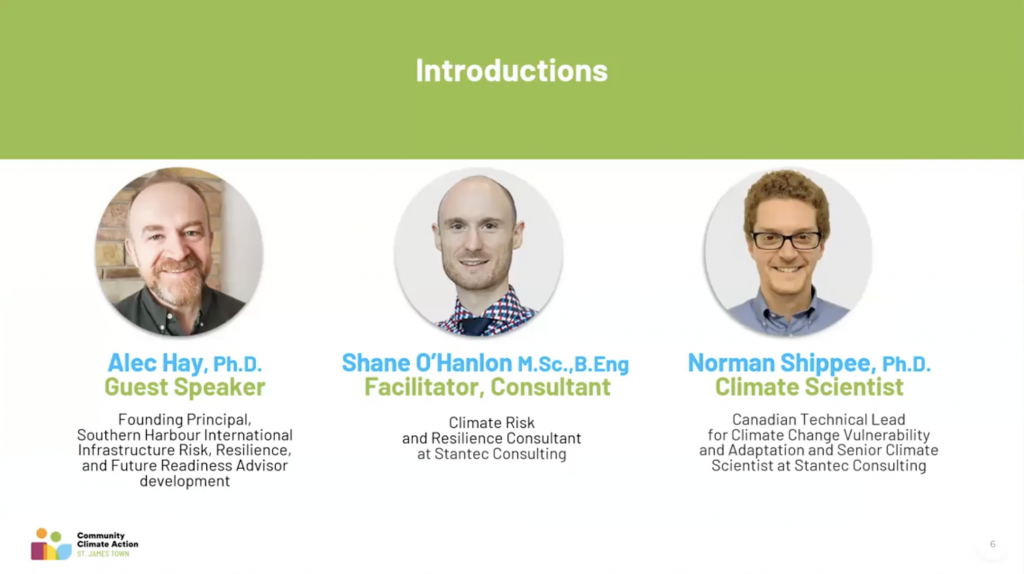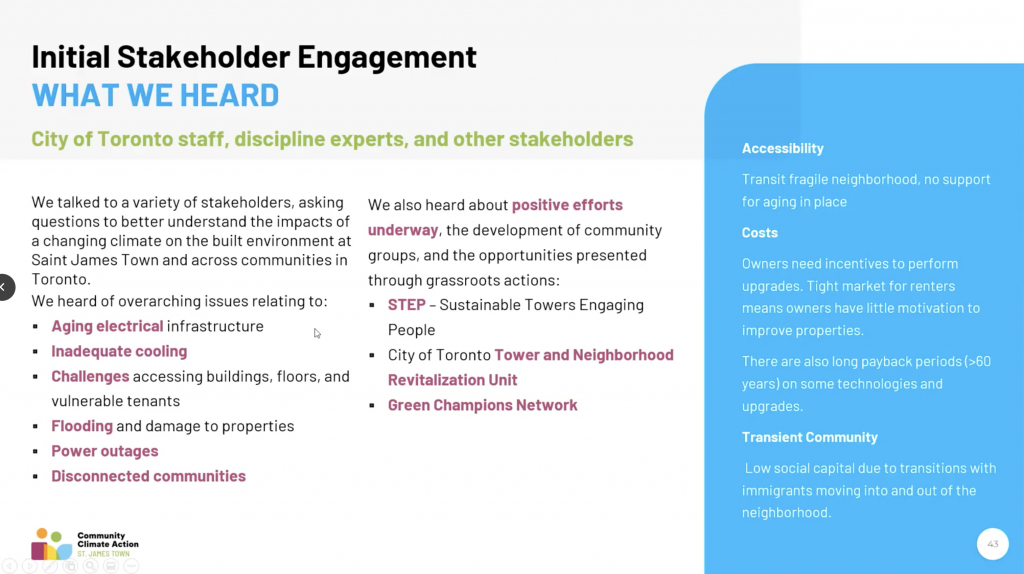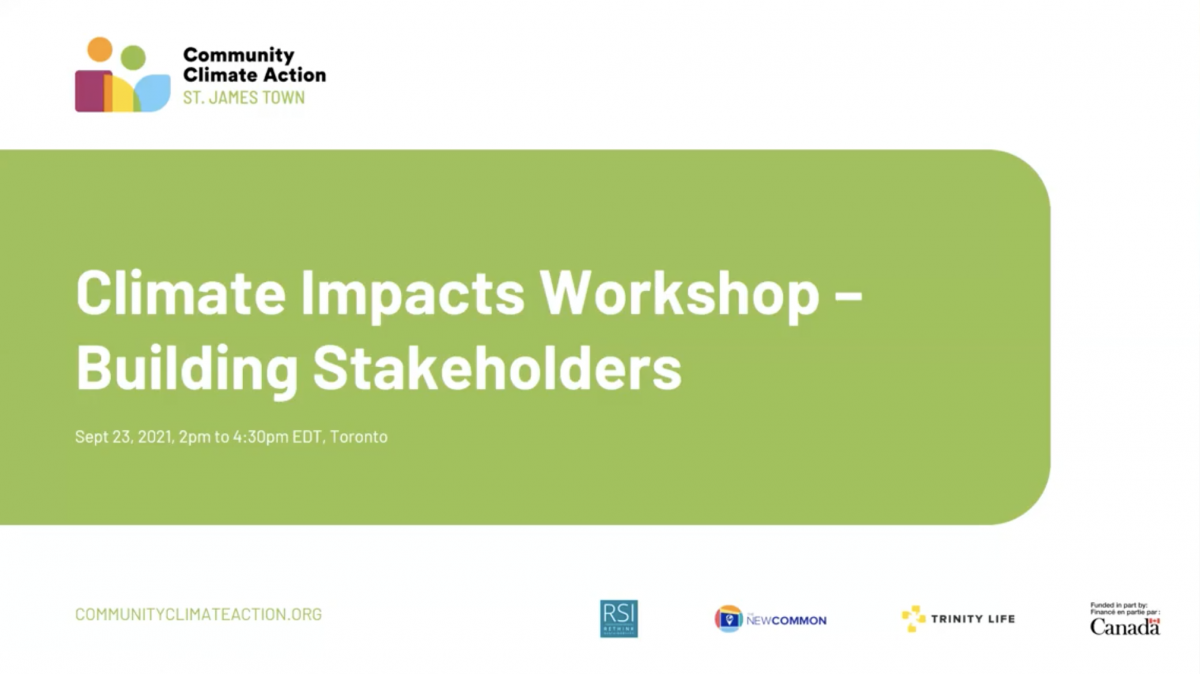Community Climate Action in St James Town (SJT) was founded to help battle the impact of climate change on high-rise communities, by engaging the entire community. The goal is to help St. James Town become the best-prepared high-rise community in regard to climate change in the city.
On Sept 23 climate consultant Shane O’Hanlon facilitated a workshop on the impact of climate change in four key categories: buildings, amenities, surrounding areas and quality of life.

After an introduction by RSI Founder and the Community Climate Action project leader, Yasmin Glanville, featured speakers Dr. Alexander (Alec) Hay, and Climate Scientist Dr. Norman Shippee, provided global and community focused insights on the impacts of climate change on urban communities. Workshop deepened the conversation in four climate impact breakout groups: buildings, amenities, surrounding areas and quality of life.
Keynote: Our World is Changing
Alec talked about the nature of what’s happening: not just the changing climate and extreme weather, but the increasing pace of change. He also pointed out the significance of climate change coinciding with major geopolitical and technological changes. It means the consequences of climate change are more profound and broader. Plus, we now have a reduced capacity to tolerate change.
He also shared information showing insurance losses over almost 40 years, due to extreme weather events, as a way of illustrating potential, real-world impact. He also presented the limits of engineering predict and remediate related threats. One of the key challenges is that historic events and underlying assumptions are no longer relevant, so there is a challenge in predicting and planning.
Managing the changes
Shared common characteristics observed of resilient and sustainable communities.
- Common focus
- Identify as a community
- Infrastructure balanced by needs
- Inclusivity
- Confidence in leadership
Alec provided examples where the presence of these characteristics made a proposed solution more successful. One example revolving around making groceries more accessible demonstrated how community groups are crucial to meaningful change that brings forward the values a community wants.
Community Housing is Key
The ability for a community to recover from disaster rides heavily on community housing, he said. If there is shelter and care for the most vulnerable and disadvantaged members of the community, municipal and commercial resources can focus more on recovery and economic development.
Residents, building owners and managers, the community and the municipality all have to work as partners. The divide between building owners and residents needs to be overcome so that communities can identify their common priorities.
Climate Science, Hazards and Trends
Climate Scientist Norman Shippee says climate change is simple, serious and solvable.
There are a lot of complex issues around climate change, but the concept of what’s causing it is really quite simple: burning fossil fuels puts more CO2 into the atmosphere, causing the temperature to rise. The effects of which are exacerbated by human activity. There is absolutely no doubt that humans are the cause of climate change.

It’s also a serious problem, causing events we’ve never seen before with far-reaching consequences. Norman shared temperature projections over the next several decades to underscore the threat. Toronto has experienced temperatures over 30°C per year for 10 or so days a year. If things carry on, Toronto could see up to 80 days a year of such high temperatures. Our infrastructure isn’t prepared for that.
When it comes to winter, fewer extremely cold days may not seem so bad, but precipitation is an issue and much less predictable, all year long. We are seeing more extreme weather events: rain, wind, temperatures, etc. For example, the polar vortex we’ve come to know recently always existed, though historically closer to the North Pole. Because of a less stable jet stream, the polar vortex is moving south more often. Cold outbreaks still happen.
Extreme weather events, even if you have not been impacted by one, need to be included and considered as part of climate impact and when looking at infrastructure planning. These events can become not only an infrastructure issue but a human health problem or a transportation problem. Many people don’t realize how much Southern Ontario has been impacted by extreme rainfall and wind, causing large and expensive damage already.
‘Small changes in climate matter – especially for wind extremes.’
Norman Shippee

The climate crisis is solvable. We need to make big cuts fast. Engineering is more concerned with climate extremes. However, building codes and standards are based on historical climate information over a 30-year average, with little looking forward. Climate is changing so quickly that this approach will not allow for reasonable adaptation or remediation. If you are doing a building retrofit now that is supposed to last 30 years that is based on 30-year-old data, the retrofit could become completely irrelevant quickly. Something needs to be done differently.
A Bit of Inspiration
If we consider how fast technology has advanced over the last 100 years, we can tackle this.

Breakout Groups
In the breakout groups, attendees looked at four categories: buildings, amenities, surrounding areas and quality of life. Groups consisted of a mix of commercial real estate agents, building managers, scientists and community residents.

It’s more obvious what climate change means for the buildings themselves, such as increased operating costs and repairs. The impact on quality of life is more difficult to imagine. One attendee shared her experience of living without basic amenities when the electricity failed during a period of extreme cold. Extreme weather events especially could lead to inaccessibility and health issues for St. James Town’s most vulnerable people.
Challenges include where to begin when it feels like there are only so many resources and you have to choose your battles. Also, in communities like St. James Town, there is little physical space to improve or repair buildings and (with tight rental profits) little motivation to do so.

Moving Forward
One realization from the breakout groups was that people from outside a given community shouldn’t assume anything; they can’t possibly understand. Community experiences vary greatly and outside experience is different. Often policies are formed by people who have no relation to the community or experience of daily life there. A great example was the potential use of the ravine as a cooling or green area. It may be a great idea, but local knowledge suggests safety will need to be considered.
In one breakout group, it was acknowledged that the pandemic has revealed a lot of weaknesses in communities like St James Town and that doing things traditionally is not going to work. To really make change within the buildings and the community, it has to come from within. The people in those communities need to be vocal, empowered and given space to act.
Building a Partnership
It is clear that the best way to ensure that communities like St. James Town are ready for climate change in the city, change has to be driven from within. There needs to be cohesion within the community. The subject matter experts in the breakout rooms made the point that all the problems are solvable. But identifying the core group within the community that will take things forward is the key. Partnerships need to be formed across the community — with residents, government, commercial interests and importantly, with building owners.

